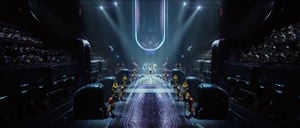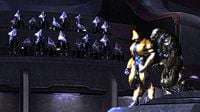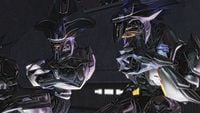High Council
From Halopedia, the Halo wiki
| High Council | |
|---|---|

| |
| General overview | |
|
Type: |
Executive/legislative branch[1] |
|
Headed by: |
|
| Organizational overview | |
|
Affiliation: |
|
|
Part of: |
Covenant government[1] |
|
Branches: |
|
|
Headquarters: |
|
| Historical overview | |
|
Formed: |
|
|
Dissolved: |
|
The High Council was the central theocratic, aristocratic and legislative decision-making body of the Covenant.[3] Based in the High Council Chamber in the heart of the Covenant holy city High Charity, the High Council consisted of more than two hundred San'Shyuum and Sangheili High Councilors[4] and was headed by a triumvirate known as the Hierarchs or "High Prophets".
History[edit]
Origins[edit]
The High Council was formed shortly after the establishment of the Covenant. During the Covenant's early years, only the Hierarchs served on what would be the High Council. The Council was established sometime in 850 BCE and consisted of a select number of San'Shyuum and Sangheili governmental delegates, as outlined in the Writ of Union.[2]
Pre-War of Annihilation activities[edit]
Shortly after the Jiralhanae's incorporation into the Covenant in 2492, a group of Sangheili commanders went before the High Council to address the Jiralhanae's pack mentality. They claimed that the Jiralhanae's natural instincts to fight to the top of any hierarchy would prove dangerous to the Covenant. Agreeing with the Sangheili's reasonable assessment, the High Council imposed restrictions on what technology the Jiralhanae could access and encouraged any peaceful "urges" among the species.[5] In 2525, during the ascension of the Prophets of Truth, Mercy, and Regret, the High Council had been initially reluctant to support the new Hierarchs. However, the Council eventually complied.[6]
War of Annihilation[edit]
- Main article: Human-Covenant War
During the War of Annihilation, the High Council would order the complete glassing of human colonies during times of "particular religious significance". During the Battle of Kholo, the Prophet of Conviction represented the High Council and gave the order to the Shipmaster of the Fleet of Righteous Vigilance to glass the planet.[7] In 2535, the San'Shyuum High Councilors reorganized the Covenant fleets, against the desires of the Sangheili High Councilors, forming the Fleet of Particular Justice.[8] On October 20, 2552, the High Council convened to debate the fate of the Supreme Commander of the Fleet of Particular Justice, Thel 'Vadamee. Ultimately, the High Council branded 'Vadamee a heretic and sentenced him to execution.[9] However, the High Prophets intervened and 'Vadamee was given the rank of Arbiter.[10]
After the High Prophet of Regret's death on Installation 05, the High Prophets of Truth and Mercy publicly replaced the Sangheili Honor Guardsmen with the Jiralhanae. This decision was not approved of by the High Council,[11] and the Sangheili viewed this as a violation of the principle that the Covenant had been founded upon and threatened to resign from the High Council.[12] The Prophet of Truth, knowing the High Council would elect a new Hierarch to replace Regret, made his move to eliminate the Sangheili High Councilors to prevent a more moderate Prophet from being elected and ruining his grand plan to eliminate the Sangheili and humanity.[1] During the Battle of Installation 05, the San'Shyuum and Sangheili High Councilors were to meet in the Control Room of Installation 05 to make preparations for the activation of the installation. However, only some of the Sangheili Councilors and former Honor Guards — particularly those who opposed the Changing of the Guard, but were unwilling to resign from their positions - had arrived at the Control Room. A large contingent of Jiralhanae, led by Captain Melchus, entered the Control Room and proceeded to massacre the Councilors, as part of the High Prophet of Truth's plan to replace Sangheili with Jiralhanae in Covenant society.[13][11] With the expulsion of the Sangheili, the Flood invasion of High Charity and the eventual dissolution of the Covenant itself, the High Council was destroyed.[1]
Organization[edit]
The theocratic Covenant followed the orders of the High Council to the letter as they were the whole of the Covenant governance. The High Council was composed of over two hundred San'Shyuum ministers and Sangheili commanders—referred to as High Councilors.[4][14] The triumvirate of Hierarchs that led the Council had the final word on all Council matters.[9][10] The Council was responsible for determining legislation and carried out the daily affairs of Covenant.[1] In the event of a Hierarch's death, the High Council was responsible for deciding which San'Shyuum would replace the absent Hierarch.[14] A Hierarch assigning an important mission to individuals without informing the rest of the Hierarchs was considered a violation of Council protocol.[15] When a San'Shyuum minster was absent for a High Council session, the minister's vice minister would be allowed to act as a substitute in their place.[3] Additionally, a High Councilor could have another San'Shyuum accompany them to a meeting of the High Council as an assistant.[14]
The High Council seemed to have been divided into several smaller councils, with different tasks and goals which keep the Covenant up and running within all its aspects. Below the other councils, there were numerous ministries functioning within the Covenant. The lower caste members of the Covenant, such as the Kig-Yar, Yanme'e, and Unggoy, were not represented on the High Council but were instead vetted by the Ministry of Concert.[16][17] The High Council was essentially the only true council the Sangheili were a part of during their service in the Covenant.[18] The High Councilors of the Council were protected by the Covenant Honor Guard. Following the Changing of the Guard, the Sangheili Councilors were unwilling to trust the new Jiralhanae Honor Guardsmen and employed Sangheili serving in the Covenant military instead.[11]
Council composition[edit]
First Age of Reconciliation[edit]
| Position | Name |
|---|---|
| Hierarch | High Prophet of Excellent Redolence |
| High Prophet of the Glorious Journey | |
| High Prophet of Unity | |
| San'Shyuum High Councilor | Prophet of Inner Conviction |
| R'Noh Custo |
Twenty-Third Age of Doubt[edit]
| Position | Name |
|---|---|
| Hierarch | High Prophetess of Obligation |
| High Prophet of Tolerance | |
| High Prophet of Restraint |
Ninth Age of Reclamation[edit]
Production note[edit]
The in-game High Council is far smaller than its canonical incarnation, being depicted by only 38 Prophets and 40 Elites. 'Vadamee, Tartarus and his two attendants, and fourteen Honor Guardsmen are also present. The Council, however, appears to be much closer to its canonical size in Halo 2: Anniversary.
Gallery[edit]
Supreme Commander Thel 'Vadamee before the High Council.
List of appearances[edit]
- Halo: The Flood (First appearance)
- Halo: First Strike
- Halo 2
- Halo: Contact Harvest
- Halo Wars: Genesis
- Halo: Helljumper (Mentioned only)
- Halo: Evolutions - Essential Tales of the Halo Universe
- Halo: Glasslands (Mentioned only)
- Halo: Mortal Dictata (Mentioned only)
- Halo: Broken Circle
- Halo 2: Anniversary
- Halo: Hunters in the Dark (Mentioned only)
- Halo: Shadows of Reach
- Sacrifice (Mentioned only)
- Halo: Outcasts (Mentioned only)
- Halo: Age of Retribution
Sources[edit]
- ^ a b c d e f g h i j Halo Waypoint - Universe, High Council (Retrieved on Oct 27, 2015) [archive]
- ^ a b Halo: Broken Circle, chapter 13
- ^ a b Halo: Contact Harvest, page 154
- ^ a b Halo: Contact Harvest, page 271
- ^ Halo: Contact Harvest, page 199
- ^ Halo: Contact Harvest, page 380
- ^ Halo: Evolutions - The Return
- ^ Halo: The Cole Protocol, page 349
- ^ a b Halo 2, campaign level The Heretic
- ^ a b Halo 2, campaign level The Arbiter
- ^ a b c Halo: Broken Circle, chapter 16
- ^ Halo 2, campaign level Sacred Icon
- ^ Halo 2, campaign level Uprising
- ^ a b c Halo: Broken Circle, chapter 15
- ^ Halo: Broken Circle, chapter 4
- ^ Halo: Contact Harvest, page 150
- ^ Halo Encyclopedia (2009 edition), page 155
- ^ Halo: Glasslands, page 58
| ||||||||||||||





